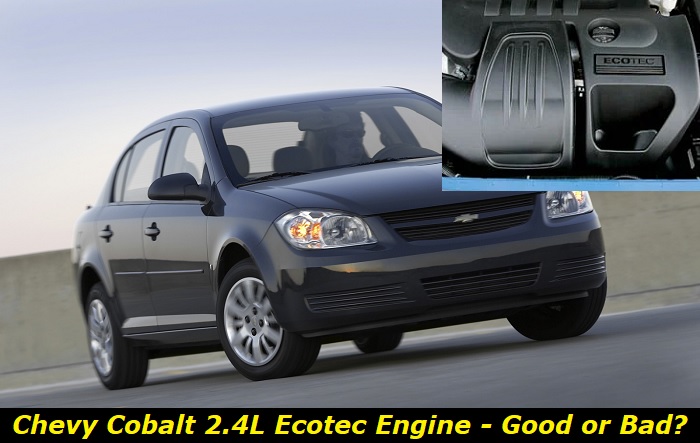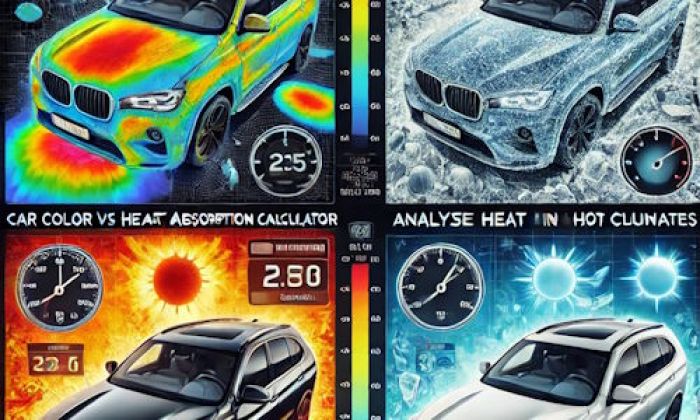The Chevrolet Cobalt first rolled into the market with a bang in 2004 as a 2005 model year car. It came as a replacement for the Chevy Cavalier and the Geo/Chevy Prizm compact cars, and it was available in sedan and coupe forms.
The first-generation model of the Chevy Cobalt made from 2004 to 2010 housed a 2.4L LE5 inline-four engine designated as the LE5 by the American automaker. In its production years, there were several recalls of the car over safety issues, and a few of them were directly related to the engine. In this article, let's take a look at the ups and downs of the 2.4L inline-four engine powering the Cobalt to confirm whether or not it's for keeps.

Key features and my opinion about the engine
- Production years:2005-2012
- Average lifespan of LE5:210,000-230,000 miles
- Fuel supply type:port injection
- Power range:165-177 hp
- Fuel efficiency:bad
- Engine block material:aluminum
- Engine reliability score:medium
- The most common problems:weak timing chain, weak balance shaft chain tensioner, phasers may go bad quickly, oil consumption.
Specs of the 2004-2010 Chevrolet Cobalt 2.4L Engine
The 2.4L engine used by the 2004-2010 Chevy Cobalt comes from General Motors (GM) successful Ecotec line. It definitely had bigger shoes to fill for being the larger version of the Ecotec.
The production of the 2.4L LE5 engine far outlived the first generation of the Cobalt as it had undergone a series of upgrades to match its various applications and to remain competitive in the market. The engine came in with 2,384 cc displacement, giving it a lot of edge over the 2.2L in terms of power and efficiency. Like its predecessor, the 2.4L engine was offered in all-aluminum block and head and it operated under atmospheric pressure.
For its application in the 2004-2010 Chevy Cobalt, the powerplant came with a bore of 88 mm and a stroke of 98 mm. The intake and exhaust of the 2.4L engine are managed via variable valve timing (VVT) technology. The adoption of the system in the unit paved way for better timing, duration, and lift of valve events that highly contributed to enhanced low-end torque. It also possessed a dual overhead camshaft that utilizes a chain-driven system.
Moreover, a conventional sequential multi-point fuel injection (MPFI) system is integrated into the engine for providing a further boost in fuel efficiency. This is intended to make every drop of gas in the 2.4L engine matter by ensuring that it supplies the right amount of fuel in accordance with any given scenario and that the correct air-fuel ratio is observed.
The layout of the power unit allowed a compression ratio of 10.4.1. The high compression ratio translates to improved thermal efficiency. A high ratio lets an engine extract more energy from the combustion process and it generates higher combustion temperatures while using less fuel.
In the 2004-2010 Chevy Cobalt, the 2.4L engine is configured to deliver 173 hp at 5,600 rpm and 163 lb-ft of torque at 4,000 rpm. The numbers propel the sedan version of the Cobalt from 0 to 60 mph in 7.8 seconds while the coupe can achieve the same feat in 7.4 seconds. These are sluggish by today's standards but pretty decent enough for their time.
Longevity of the 2004-2010 Chevrolet Cobalt 2.4L Engine
Save for its common problems, many of which happen to be more prevalent due to age, the 2.4L engine is a durable product. One of the things that long-time users praise about it is its reliability. If the issues about the engine are caught early on through regular maintenance, its lifespan could be stretched as far as 200,000 miles. Likewise, users have to ensure that it is always properly lubricated and cooled by keeping track of its fluid levels and quality.
Common Problems Found in the 2004-2010 Chevrolet Cobalt 2.4L Engine
The 2004-2010 Chevrolet Cobalt has been subjected to numerous recalls over the years. Most of them stem from airbag, padding, or electrical issues. There were a few complaints related to the engine, but the most serious ones that have been linked to it are a couple of problems with the ignition system.
1. Faulty Ignition Switch
From the get-go, the first-gen Chevy Cobalt has been plagued by ignition system problems. One of the most common problems with the Chevy Cobalt's ignition system can be found in the ignition switch. The ignition switch is responsible for sending an electrical signal from the key to the starter solenoid. Once the starter solenoid receives the signal, it closes a circuit that allows current to flow to the starter motor.
If the ignition switch is faulty, it can prevent the starter solenoid from receiving the electrical signal. As a result, the engine won't start.
There are several symptoms that can indicate that the ignition switch is failing. The most obvious sign is that the engine won't start when you turn the key. In some cases, you may be able to start the engine, but it will stall immediately after starting.
Another symptom of a failing ignition switch is intermittent electrical problems. This can manifest itself in several ways, such as the headlights flickering or the radio cutting in and out.
If you're experiencing any of these symptoms, you must get your ignition switch checked by a qualified mechanic. They will be able to diagnose the problem and replace the switch if necessary.
An alternative solution to go around the issue is to install a bypass switch. This will allow you to start the engine without using the ignition switch. This can be useful if you're having intermittent electrical problems.
Lastly, you may want to consider installing a higher-quality ignition switch. This can be a bit more expensive, but it will help to prevent future problems.
2. Ignition Coil Failure
One more root of the problem within the Chevy Cobalt's ignition system is the ignition coil. The ignition coil is responsible for providing the spark that ignites the air-fuel mixture in the cylinders. If the ignition coil is faulty, it can prevent the spark plugs from firing. As a result, the engine won't start.
There are several symptoms that can indicate that the ignition coil is failing. One of the most obvious signs is that the engine won't start when you turn the key. In some instances, you may be able to crank the engine, but it will die down immediately after starting.
Another symptom of a failing ignition coil is a misfiring engine. If you're experiencing misfires, you'll notice that the engine will run rough. In some cases, you may also see a decrease in fuel economy.
If you're having problems with your Chevy Cobalt's ignition coil, it's important to have it inspected by a qualified mechanic. They will be able to investigate the problem thoroughly and come up with the best solutions. Normally, the answer to it entails replacing the damaged part or cleaning it if carbon build-up is the only thing preventing its functionality. Do note that whenever the ignition coil is replaced, it is recommended for the spark plugs to be changed as well.
3. Damaged Timing Chain Tensioner
The 2004-2010 Chevy Cobalt 2.4L engine is known for having timing chain tensioner problems. The signs of a damaged timing chain tensioner include an engine noise that gets louder as the engine speed increases, a rattling noise from the front of the engine, reduced engine power, and poor fuel economy.
The usual causes of the issues can be worn out or damaged timing chain tensioner parts and improperly adjusted timing chain tensioner. To fix these issues, you will need to have the chain tensioner recalibrated to its recommended setting. In case of damage or heavy wear, it should be replaced with a new part.
4. Fuel Leak in the Reservoir
The 2004-2010 Chevy Cobalt is known to develop cracks in the fuel reservoir. This issue commonly happens in places where summer can get really hot. The heat causes the material of the part to become brittle and crack, and there are a few ways to tell if your car has this problem.
The most common symptom of a fuel leak in the reservoir is a strong gasoline smell coming from the car and fuel residue on the ground your auto is parked. Other symptoms can include the check engine light coming on, or your car running out of gas faster than before.
To fix this problem, you'll likely need to replace the entire fuel reservoir. In some cases, you may also need to replace other parts of the fuel system like the fuel pump or fuel injectors if the problem has reached those components.
If you think you might have a fuel leak in your Cobalt, don't hesitate to take it to a mechanic. It's a pretty easy fix, and it's definitely better than dealing with the consequences of driving around with a dangerous gas leak.
Do We Recommend the 2004-2010 Chevrolet Cobalt 2.4L LE5 Engine?
It's hard to say no to a car that can potentially last around 200,000 miles. That's up to two decades of use under normal driving conditions. Despite the ignition problems the 2004-2010 Chevrolet Cobalt is known for, its overall packaging makes it a very reliable vehicle. Just remember to watch out for the early signs of possible problems and have them fixed without delay to truly enjoy your experience with it.
About the authors
The CarAraC research team is composed of seasoned auto mechanics and automotive industry professionals, including individuals with advanced degrees and certifications in their field. Our team members boast prestigious credentials, reflecting their extensive knowledge and skills. These qualifications include: IMI: Institute of the Motor Industry, ASE-Certified Master Automobile Technicians; Coventry University, Graduate of MA in Automotive Journalism; Politecnico di Torino, Italy, MS Automotive Engineering; Ss. Cyril and Methodius University in Skopje, Mechanical University in Skopje; TOC Automotive College; DHA Suffa University, Department of Mechanical Engineering






Add comment